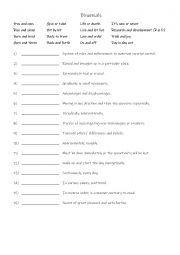
|
Binomials - common pairs of words 1b
Students read the definitions and match them with the correct pair of words.These pairs are often used for their rhythmic and memorable qualities, making the language more engaging and easier to remember.In English grammar, binomials are expressions where two words are joined by a conjunction (usually "and" or "or") to form a fixed phrase. These wo...
Level: intermediate
Age: 12-100
Type: worksheet
Downloads: 117
|
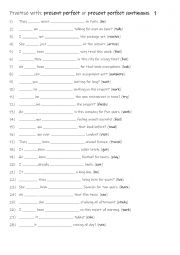
|
A2+-B1 Practise with present perfect or present perfect continuous 1
Students should practice the present perfect and present perfect continuous tenses because they help express actions or experiences connected to the present. The present perfect describes past actions with current relevance (e.g., "I have visited Paris"), while the present perfect continuous emphasises ongoing actions or their duration (e.g., "I ha...
Level: intermediate
Age: 10-100
Type:
Downloads: 126
|
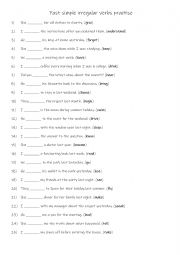
|
A1+ -A2 Past simple irregular verbs practise
Students read the sentences and complete the gap-fill using the given infinitive in () at the end of each sentence. Answers on page 2.
Level: elementary
Age: 7-100
Type:
Downloads: 104
|
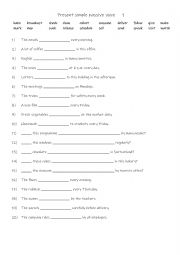
|
Present simple passive voice 1
Learning the present simple passive voice helps students focus on the action or the recipient, rather than the doer. It�s useful when the doer is unknown, unimportant, or to emphasize the object. Mastering this structure improves clarity, variety in sentence construction, and is essential for formal or academic communication. Students complete the ...
Level: elementary
Age: 10-100
Type:
Downloads: 106
|
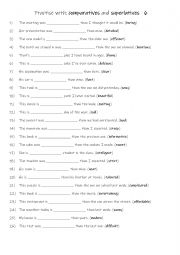
|
A1+-A2 Practise with comparatives and superlatives 6
Students read the sentence and complete the sentence with the correct form of the given adjective in (). Each form is used 13 times! Answers on page 2.
Level: elementary
Age: 8-100
Type:
Downloads: 108
|
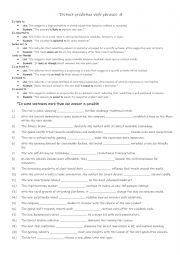
|
A2+-B1 7 Distinct prediction verb phrases 4
These phrases help express different levels of certainty about future events. "Is likely to" suggests something will probably happen based on evidence, while "is expected to" refers to something predicted or planned. "Seems set to" indicates something is prepared to happen soon, and "looks as though" is used when something seems probable based on c...
Level: elementary
Age: 9-100
Type: worksheet
Downloads: 145
|
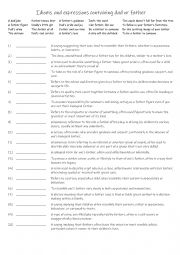
|
Idioms and expressions containing dad or father B1+-C1 (1)
Learning phrases about fathers improves cultural literacy, communication, and creativity in language use. Expressions like "Like father, like son" and "The apple doesn�t fall far from the tree" help students understand societal views on family and inheritance. Figurative phrases like "Dad�s taxi service" or "A father�s love" add depth and emotional...
Level: intermediate
Age: 10-100
Type:
Downloads: 110
|
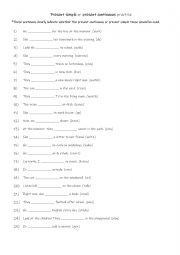
|
Present simple or present continuous practise
Students read the sentences and work out if the given infinitive need tobe in present simple or past simple tense.Present simple or present continuous practise
*These sentences clearly indicate whether the present continuous or present simple tense should be used.
Answers on page 2
Level: elementary
Age: 10-100
Type:
Downloads: 111
|
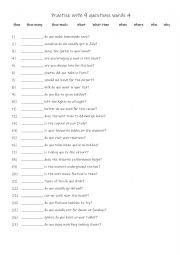
|
Practise with 9 questions words 4
Students familiarise themselves with the 9 question words and their use. Then they read the questions to see which question word is required to complete the questions. Answers on page 2.
Level: elementary
Age: 7-100
Type:
Downloads: 144
|
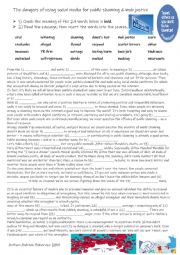
|
The dangers of using social media for public shaming & mob justice.
Reading passage with a gap fill exercise about the risks involved using social media to shame someone who (allegedly) has committed a 21st century socially unacceptable crime! This sheet is suitable for higher level B1 to C1 students of all ages. An answer sheet is included. For higher level students they could be put in groups to give / present th...
Level: intermediate
Age: 12-100
Type: worksheet
Downloads: 2157
|












